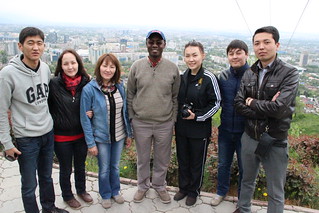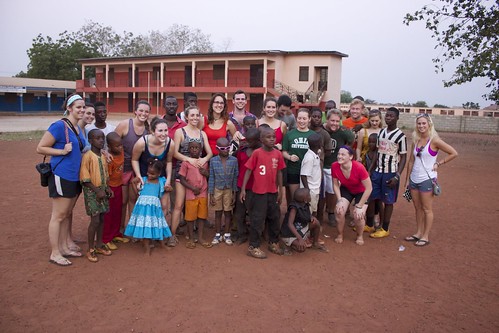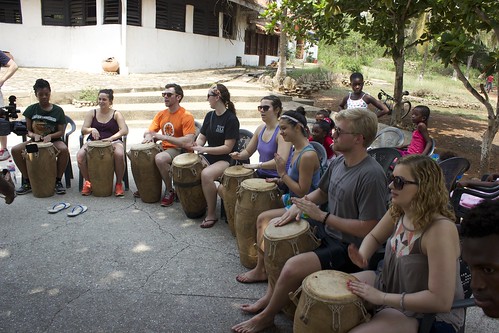
The Institute for International Journalism in collaboration with Al-Farabi Kazakh Nation University (KazNU) has entered into research venture to work with KazNU’s Faculty of Journalism to conduct consultations and lectures from Feb. 21 through March 8. This partnership was made possible through the Study of the U.S. Institute (SUSI) on Journalism and Media post-institute activities.
IIJ Director, Dr. Yusuf Kalyango, will lead lectures and consultations, most of which last three and half hours, each weekday of the trip in the Faculty of Journalism at KazNU. Lectures and consultations will be open to faculty members, graduate students and undergraduate students.
Graduate research students will attend lessons on quantitative research, such as designing, collecting data, theorizing and publishing in American or European Academic Journals.
Kalyango’s lectures for undergraduate students will be based on a course offered at KazNU: “Role of Televised (Visual) Media and Democratization (TV News).” Their lectures and consultations include conceptualizing research ideas, formulating hypotheses, collecting, and analyzing data, or the “A to Z of Public Opinion Empirical Research.”
KazNU students and lecturers will present their findings on the last weekday of Kalyango’s visit: Friday, March 7. KazNU Rector Dr. Mutanov Galimkair Mutanovich and OU President Dr. Roderick J. McDavis last year signed a Memorandum of Understanding, a formal agreement establishing a partnership, between the two institutions.
"Developing and fostering strong partnerships with universities around the globe is an important aspect of our commitment to diversity and an important way that we enrich the student experience at Ohio University," OU President Roderick J. McDavis said in a Compass blog post.
Kalyango’s lectures and consultations at KazNU will be part of the IIJ-SUSI post-Institute program events. The SUSI summer institute is funded by an annual renewable grant from the U.S. Department of State’s Study of the U.S. Branch in the Office of Academic Exchange Programs. Scholars from all over the world come to the E.W. Scripps School of Journalism at Ohio University to be exposed to journalism practice and media institutions in the United States, according to a previous Institute for International Journalism post.
At last year’s academic trip, Kalyango’s lectures revolved around topics such as global news coverage and reporting conflicts, and the consultations were related to a course: Higher Education, Professional Development and Research Opportunities in the USA. He also held a workshop called Teaching and Grading with Multimedia Online Tools in Classrooms and Seminars, on his final day in Kazakhstan.
Between lectures, consultations and workshops, Kalyango also experienced the Kazakh culture by traveling around the country with an alumna of the 2012 Study of the U.S. Institute at Ohio University, indulging in traditional foods and attending shows at locally significant theaters.

Saturday, February 15, 2014
IIJ Promoting Graduate Research in Journalism in Kazakhstan
WJS Researchers gather in Greece to Discuss Data, Methodology and attend ECREA

Greece, a country that is home to ancient architecture, art museums and historical monuments, will host the Worlds of Journalism Study convention this spring for member-scholars to discuss and analyze the evolution of journalism around the globe.
The Worlds of Journalism Study, a research group established in 2006, will host its 2014 convention in Thessaloniki, Greece March 27-29.
According to the Worlds of Journalism Study’s (WJS) official website, the organization “is an academically driven project that was founded to regularly assess the state of journalism throughout the world.
“The Study’s primary objective is to help journalism researchers, practitioners, media managers and policy makers better understand world views and changes that are taking place in the professional orientations of journalists, the conditions and limitations under which they operate, as well as the social functions of journalism in a changing world.”
The organization is a product of researchers from 80 countries, including Kenya, Malaysia and Ecuador, among others.
Chair of the Worlds of Journalism Study, Dr. Thomas Hanitzsch, said “This type of collaboration is, to the best of my knowledge, the first in the field.” He observed that this kind of research collaboration is “much more common in other fields (such as science)... (The Worlds of Journalism Study is) the largest collaboration in the field of communication studies.”
Hanitzsch’s interest in comparing global journalism culture sparked when he finished his Ph.D. studies in Indonesia, and was motivated to seize the opportunity to compare Indonesian journalism to other country’s approaches.
The European Communication Research and Education Association (ECREA) posted an itinerary online; the event will include featured keynote speakers and several parallel sessions.
ECREA’s theme for this year’s convention is, “Journalism in Transition: Crisis of Opportunity?” which is the kind of question that researchers at the Worlds of Journalism Study are trying to explore.
Tim Vos, associate professor and coordinator for global research initiatives at the University of Missouri and one of the U.S. primary investigators for the Study, said there is a lot to analyze based on data collected from journalists of all ages in various cultures.
“The convention promises to be an academically productive and internationally well-attended event,” Hanitzsch said in a letter.
He explained that at the convention, researchers are expected to present their findings from their studies of certain countries, reflect upon the methodology and discuss future steps in the Worlds of Journalism Study.
Some of the countries to be discussed include Rwanda and Tanzania, which was studied by Director of the Institute for International Journalism (IIJ), Dr. Yusuf Kalyango.
Approximately 400 journalists were surveyed on their journalism approaches for researchers to analyze the similarities and differences in the culture of the field around the world. According to Hanitzsch’s letter, the final data is due in December.
Vos said the U.S. is “ahead of the game” in its research, but added that some researchers have “only just begun” to analyze what they have found so far.
Hanitzsch said that the process of the study remains ongoing, and the collaborators will discuss how to continue research and the future structure of the Worlds of Journalism Study at the Greece conference.
“The whole landscape or environment of journalism is changing,” Vos said. “Journalism cultures are reacting to each other and (trying) to get a sense of what’s driving some of those changes.”
He added that part of the future of the Study involves publishing a book after analyzing and publishing the results of the data. Hanitzsch said that the Worlds of Journalism Study’s data are expected to be published in mid-2015, and expects the book to be on shelves approximately two years later.
IIJ’s Ghana program tests new waters, builds new relationships
Sunday, February 9, 2014
Journalism in Ghana: Police escorts, brown envelopes and more
By Lindsay Boyle
“Don’t be hard-hitting.”
That’s what I was told on my first day as an intern at the Daily Graphic, Ghana’s state-owned and best-selling national newspaper. I was warned that, sometimes, the Graphic would find a reason to fire those who were.
Now, I don’t want to completely knock Ghanaian journalism: not only are other countries allowed to do things differently, but also, the United States’ way of going about things isn’t perfect — the 2013 Reporters Without Borders Press Freedom Index, although controversial, listed it below 31 other countries. And, recently, a study by PEN America found that many U.S. writers are now self-censoring in order to avoid NSA scrutiny.
Regardless, some of the journalistic trends I observed during my two months as an intern with the Daily Graphic were disconcerting.
Every evening, the Graphic’s schedule for the following day — the “roaster” — is posted. Typically, it features almost nothing but press conferences, awards shows and other similar conventions. However, that alone isn’t the problem — it’s more so the way journalists go about covering the already PR-like events.
Even when reporters — not just from the Graphic — aren’t late, they sometimes fall asleep during events and rely on the typed-up speeches to write their stories. At one press conference about offshore drilling — where two British folks and a Ghanaian gas company owner talked about how awesome the practice would be — the Ghanaian journalists were so adamant about getting the speeches afterward that employees had to make copies on the spot.
I should note that, at the same conference, the reporters asked an uncannily small amount of questions. Not one person thought to bring up the potential adverse effects offshore drilling could have on Ghana environmentally. Following the public Q & A session, the reporter I was with still didn’t ask anything, even though the reporter could have done so one-on-one.
The problem goes farther than that, though: with conferences and other events — even ones that are days long — reporters from all media outlets rarely stay for more than the welcome ceremony. When I was covering a three-day conference on accessibility and quality of higher education, a Graphic photographer told me we needed to leave after we’d been at the event for just 25 minutes. What? I thought. What’s the point of even going? This will be a total fluff piece.
I rushed to find a man who was giving a presentation later during the conference specifically about Ghana, so I could at least have some quotes with real details. I didn’t see any other reporters do the same.
Instead, when I returned, I found the photographer waiting with other media members to receive money from the university that hosted the event. Again, what? I later learned it’s a common practice in Ghana that’s widely known as ‘soli’ — short for ‘solidarity’ — and is considered more of a courtesy than a bribe to write good things.
Perhaps I’d be more comfortable with that if it weren’t for the police escort Graphic reporters, myself included, received from an event at the Embassy of Japan a week earlier. Yes, that’s right: I rode, four in the backseat, in a police SUV with its sirens blaring, flying down the wrong side of the road as cars swerved out of the way just in time.
There was no hurry — we were just going back to the office to write about a Community-based Health Planning and Services compound. But, that’s the effort the police made for the journalists — the same journalists who are supposed to keep the actions of the police in check.
Anyway, when we returned to the office, the reporter with whom I went asked me to write the story while she also wrote it. When she read my version, she told me all the ways my article was wrong: it didn’t hop around erratically — it went in order of importance. It didn’t feature subheads every three graphs — it flowed well. The reporter’s version ran the following day with a shared byline. Agortoe, the main location to which the piece referred, was spelled “Argotoe” at two different points.
Editing errors such as that weren’t uncommon, either. When I wrote about a conference/awards event regarding sanitation in Ghana, my article ran the following day with an “edited” lead that ended with a comma rather than a period.
And, I was told my story from the conference on accessibility and quality of higher education didn’t “follow our style.” Where I had a short lead, it became 80 words long and tough to follow. Where I had two sentences, it became one run-on. Where I had words spelled correctly and plurals agreeing, they no longer were. Where I had “Prof Peter Mayer, from Osnabrueck, Germany,” there was “Prof Peter Mayer Osnabrueck, from Germany,” who was thereafter referred to as “Prof Osnabrueck.”
Seriously.
Fortunately, the Daily Graphic has a features section to expand on its regular coverage. With that, though, comes a different issue: actually trying to report a feature story in Ghana.
In Ghana, a freedom of information bill that’s existed since 2003 still hasn’t been signed into law. Many organizations and events have poor or nonexistent websites. But, what’s worse is how difficult it was, at least for me, to get a hold of government members.
When I needed information about why an island near Ada still isn’t on Ghana’s national electricity grid, Comfort Doeyo Cudjoe Ghansah, Member of Parliament for Ada, answered one email — asking me when I’d like to meet — but then never replied to my response. An NGO employee working in the area told me she’d never gotten back to him, either.
When I was working on a story about child trafficking in Ghana, I walked more than 30 minutes to the Ministry of Women’s and Children’s Affairs — which became the Ministry of Gender, Children and Social Protection with very little publicity — because none of the several phone numbers listed for the place worked.
Employees there sent me to the Department of Children, which they said would be able to better answer my questions, with such terrible directions that I actually couldn’t find it until I tried again two days later.
There, I was told I should actually go to the Human Trafficking Secretariat for answers. I trekked almost three miles to the building only to find that the head of the secretariat, Victoria Natsu, wasn’t there and hadn’t been all week. I refused to leave until someone gave me her phone number.
A few days later, I did an interview with her, oddly enough, at the Ministry of Gender, Children and Social Protection.
On the bright side, the Graphic did run my piece on trafficking — it received a two-page, center-of-the-paper spread — even though it could easily be considered “hard-hitting.” Additionally, the right to information bill seems closer to passage than ever, major outlets are starting to denounce ‘soli’ and increasing Internet access will inevitably lead to more, and better, websites. So, it seems Ghanaian journalism, at least, is headed in the right direction.







